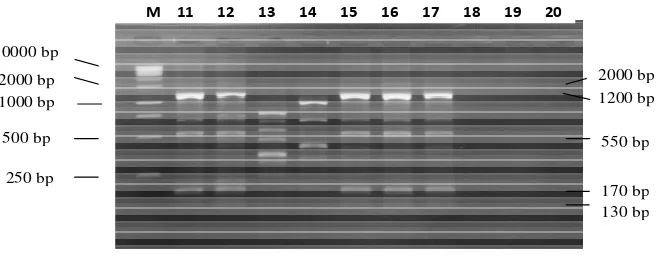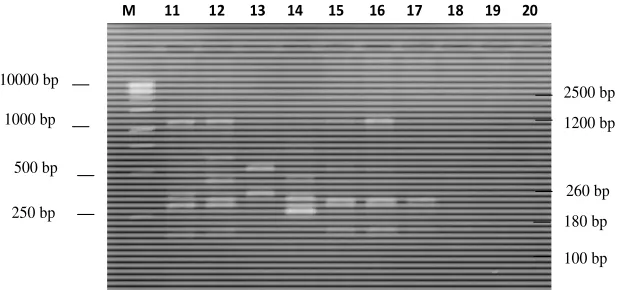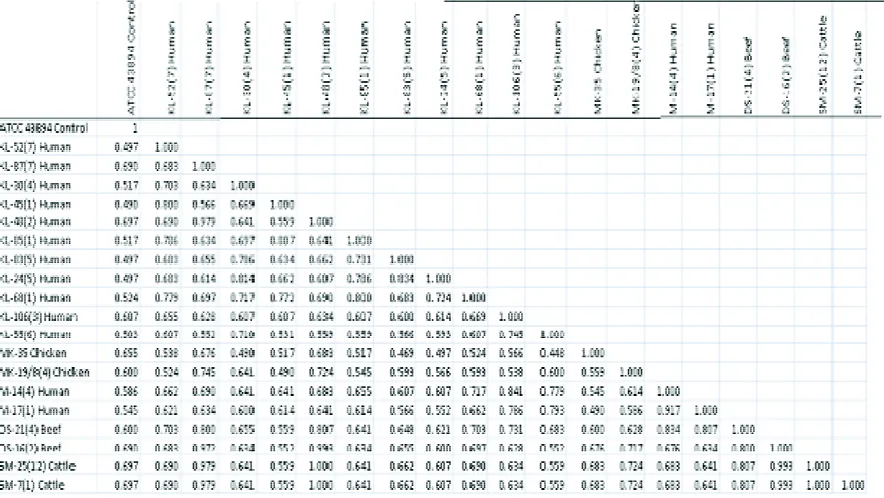International Research Journal of Microbiology (IRJM) (ISSN: 2141-5463) Vol. 4(2) pp. 72-78, February 2013 Available online http://www.interesjournals.org/IRJM
Copyright © 2013 International Research Journals
Full Length Research Paper
Genetic Diversity of
Escherichia coli
O157:H7 strains
using random amplified polymorphic DNA (RAPD)
I Wayan Suardana
1*, Wayan Tunas Artama
2, Dyah Ayu Widiasih
3and
I Gusti Ngurah Kade Mahardika
4*1
Department of Veterinary Publich Health, Faculty of Veterinary Medicine, Udayana University, Denpasar. Jl. PB. Sudirman Denpasar-Bali, Indonesia
2
Department of Biochemistry, Faculty of Veterinary Medicine, Gadjah Mada University, Jl. Fauna 2, Karang Malang, Yogyakarta 55281, Indonesia
3
Department of Veterinary Publich Health Faculty of Veterinary Medicine, Gadjah Mada University, Jl. Fauna 2, Karang Malang, Yogyakarta 55281, Indonesia
4
Department of Virlology Faculty of Veterinary Medicine, Udayana University, Denpasar. Jl. PB. Sudirman Denpasar-Bali, Indonesia
Abstract
Escherichia coli O157:H7, an emerging cause of food-borne disease, has now been reported from
several countries worlwide. Cattle and sheep are known as a principle reservoir of this agent. It is also prevalent in gastrointestinal tract of other animals like pigs, dogs, cats and birds. This agent can be transmitted to humans by food and water and even person to person contact. The random amplified polymorphic DNA (RAPD) technique has been applied to evaluate zoonotic potency of
Escherichia coli O157:H7 local isolates. Ten random decamer primers have been evaluated in this study to differentiate isolates originated from humans and animals. The 02, OP-03, 04, OPA-07, OPA-08, OPA-09, OPA-10, OPA-13, OPA-19, and OPA-20 decamer primers show a good differentiation pattern of E. coli O157:H7 isolated from human, cattle and chicken feces, as well as
from beef. The primers constantly produce 16, 16, 11, 14, 8, 24, 7, 11, 7, and 12 polymorphic bands, respectively. Various human isolates that were isolated from clinically ill and healthy patients share common genetic clusters with animal isolates from beef, as well as cattle and chicken feces with genetic similarity coefficients greater than 70%. According to this result, It has been concluded the transmission of E. coli O157:H7 local isolates from animals to humans is potential occur.
Keywords: E.coli O157:H7, RAPD, genetic diversity, humans, animals, zoonosis.
INTRODUCTION
Escherichia coli is a bacterium comonly present in both animal and human intestinal tract, and also widespread in the environment. There are numerous strains, some of which are potential pathogens which can cause disease in humans through various infectious and toxinogenic mechanisms (Luciani et al., 2006).
Verotoxin producing E. coli O157:H7 strains is the predominant causative agent of hemorrhagic colitis (HC),
*Corresponding Author E-mail: [email protected]
a bloody diarrhea that can lead to hemolytic uremic syndrome (HUS), a potentially lethal renal failure (Rivas et al., 2006). Cattle and other ruminants appear to be the natural reservoir for E. coli O157:H7 (LeJeune et al., 2004). Transmission of agent to humans mainly occurs via comsumption food such as raw or undercooked meat products, which occurs as a result of contact of feces or intestinal content after slaughter and raw milk and even person to person contact (Nataro and Kaper, 1998; Rodolpho and Marin, 2007).
of strain typing, such as serotyping and bacteriophage typing have been used. However, newer molecular typing methods have been recently introduced in many laboratories. One of the PCR-based techniques is Random Amplified Polymorphic DNA (RAPD) (Dale and Park, 2004) .
RAPD technique is based on the amplification of DNA segments with a single primer of arbitrary nucleotide sequence. These primers detect polymorphisms that can be used to construct genetic maps (Williams et al., 1990). RAPD has been used successfully in the past for E. coli O157:H7 (Al-Darahi et al., 2008; Ji-Yeon Kim et al., 2005). On the order hand, RAPD method has many advantages i.e. time and cost-saving, sensitivity, and no special skills required to perform compare with order methods like Amplified Fragment Length Polymorphism (AFLP), and analysis of chromosomal DNA restriction patterns by Pulsed-Field Gel Electrophoresis (PFGE). Therefore, RAPD fingerprinting analysis was used for this study.
The purpose of this study was to evaluate the possibility of epidemiological typing of E. coli O157:H7 isolates based on RAPD analysis, in order to identify and differentiate strains of E. coli O157:H7 isolated from either animal or human origin. Futhermore, the data of RAPD analysis also can be used to depict a dendrogram so that the genetic relationship among E. coli O157:H7 local isolates can be estimated.
MATERIALS AND METHODS
Bacterial strains and DNA extractions
Escherichia coli ATCC 43894 as a control and nineteen of E. coli O157:H7 local isolates were used in this study. The local isolates originated from feces of human with Incorporation Technologies Inc. (Alameda, California, USA). These were tested on twenty E. coli O157:H7 strains as single primers for RAPD-PCR technique.
After an initial screening, on the basis of their ability to detect polymorphisms and to produce reliable and
Suardana et al. 73
scorable banding patterns, the best RAPD amplification patterns were chosen for data compilation and examination of the genetic diversity and relationship.
RAPD-PCR amplification
RAPD-PCR was carried out in 27 l reaction volumes containing 12.5 l FastStart PCR Master (Roche), 100 ng genomic DNA, 20 pmol primer, and 9.5 l ultrapure distilled water (Invitrogen). Amplification was carried out in a thermo-cycler (Biorad PTC-1148) programmed for 5 minutes at 94OC; for 36 cycles of 1 minute at 94OC, 30 seconds at 35OC and 1 minute at 72OC; and a final extension of 5 minutes at 72OC. The amplified DNA samples were separated on 2% agarose gels and detected by staining with ethidium bromide.
RAPD fingeprinting analysis
The amplified fragments were scored in a descending manner from higher to lower molecular weight product. Presence of products was designated as “1” and its absence as “0” (Al-Darahi et al., 2008).Cluster analysis was generated and analyzed using similarity coefficient and unweighted pair group algorithm with arithmetic averages (UPGMA) with coefficients similarity of each cluster ware showed near the branch of dendrogram. Data were processed using Multivariate Statistical Package (MVSP) 3.1 (Sembiring and Goodfellow, 2010).
RESULTS
RAPD Profile
Ten RAPD primers were applied to differentiate nineteen strains of E. coli O157:H7 local isolates and one strain of E. coli O157:H7 control (ATCC 43894). Table 1 showed that different primers generated variable numbers of fragments with different lengths of DNA amplified products. Its show that screening of genetic variation by 10 primers generated a various number of bands range from 7 to 16 bands. The highest number of bands (more than 10 bands) were amplified with both OPA-02 and OPA-03 (16 bands), OPA-04 (11 bands), OPA-07 (14 bands), OPA-09 (24 bands), OPA-13 (11 bands) and OPA-20 (12 bands). Total of 126 amplification products, of which 126 (100%) was found to be polymorphic with an average of 12.6 polymorphic bands per primer.
74 Int. Res. J. Microbiol.
Table 1. Number of bands and polymorphism revealed by RAPD
Primers Sequence Total
bands
Bands quality
Polymorphic bands
discriminatory Efficiency
OPA-02 TGC CGA GCTG 16 Clear 16 1
OPA-03 AGT CAG CCAC 16 Unclear 16 1
OPA-04 AAT CGG GCTG 11 Clear 11 1
OPA-07 GAA ACG GGTG 14 Clear 14 1
OPA-08 GTG ACG TAGG 8 Clear 8 1
OPA-09 GGG TAA CGCC 24 Clear 24 1
OPA-10 GTG ATC GCAG 7 Clear 7 1
OPA-13 CAG CAC CCAC 11 Clear 11 1
OPA-19 CAA ACG TCGG 7 Unclear 7 1
OPA-20 GTT GCG ATCC 12 Clear 12 1
All primers 126
Average 12,6
Figure 1a. RAPD patterns of E. coli O157:H7 strains produced by OPA-2 primer. Electrophoresis was performed on 2% agarose gel. Line 1 positive control : ATCC 43894; 2: KL52(7); 3: KL87(7); 4: KL30(4); 5: KL45(1); 6: KL(48(2); 7: KL85(1); 8: KL83(5); 9: KL24(5); and 10: KL68(1); M: 1 kb DNA Ladder
Marker (Microzone Ltd cat. 1DLL-500).
250 bp 500 bp 1000 bp 2000 bp 10000 bp
130 bp 170 bp 550 bp 1200 bp 2000 bp
Figure1b. RAPD patterns of E. coli O157:H7 strains produced with OPA-2 primer. Electrophoresis was performed on 2% agarose gel. Line 11: KL-106(3); 12: KL-55(6); 13: MK-35; 14: MK-19/8(4); 15: M-14(4); 16: M-17(1); 17: DS-21(4); 18: DS-16(2); 19: SM-25(1); and 20: SM-7(1) M: 1 kb DNA Ladder
Suardana et al. 75
M 1 2 3 4 5 6 7 8 9 10
250 bp 500 bp 1000 bp 10000 bp
180 bp 270 bp 550 bp 1200 bp
100 bp
Figure 2a. RAPD patterns of E. coli O157:H7 strains produced with OPA-9 primer. Electrophoresis was performed on 2% agarose gel. Line 1 positive control : ATCC 43894; 2: KL52(7); 3: KL87(7); 4: KL30(4); 5: KL45(1); 6: KL(48(2); 7: KL85(1); 8: KL83(5); 9: KL24(5); and 10: KL68(1); M: 1 kb DNA Ladder Marker (Microzone Ltd cat. 1DLL-500).
250 bp 500 bp 1000 bp 10000 bp
180 bp 260 bp 1200 bp
100 bp 2500 bp
Figure 2b. RAPD patterns of E. coli O157:H7 strains produced with OPA-9 primer. Electrophoresis was performed on 2% agarose gel. Line 11: KL-106(3); 12: KL-55(6); 13: MK-35; 14: MK-19/8(4); 15: 14(4); 16: M-17(1); 17: DS-21(4); 18: DS-16(2); 19: SM-25(1); and 20: SM-7(1) M: 1 kb DNA Ladder Marker (Microzone Ltd cat. 1DLL-500).
variable bands amplified by OPA 2 primer i.e: 130, 170, 250, 350, 420, 500, 550, 600, 700, 750, 850, 950, 1100, 1200, 1450 and 2000 bp. Futhermore, Figure 2a, and 2b show the results of amplification by OPA-9 primer i.e: 100, 180, 250, 260, 270, 300, 325, 350, 450, 500, 550, 560, 650, 680, 700, 750, 850, 900, 950, 1000, 1200, 1350, 2000 and 2500 bp.
Dendrogram Analysis
The genetic relatedness among E. coli O157:H7 strains was ilustrated through a tree-like structure that is
generally known as dendrogram. Dendrogram generated using 10-base primers are presented in Figure 3.
76 Int. Res. J. Microbiol.
Simple Matching Coefficient
DS-16(2) Beef KL-48(2) Human SM-25(12) Cattle SM-7(1) Cattle KL-87(7) Human MK-19/8(4) Chicken ATCC 43894 Control MK-35 Chicken KL-106(3) Human M-14(4) Human M-17(1) Human DS-21(4) Beef KL-55(6) Human KL-45(1) Human KL-85(1) Human KL-52(7) Human KL-68(1) Human KL-24(5) Human KL-83(5) Human KL-30(4) Human
0.52 0.6 0.68 0.76 0.84 0.92 1
0.99 0.98 0.92
0.83
0.82 0.81 0.80
0.79
0.79 0.78
0.75
0.73 0.70
0.68 0.66 0.63 0.61
Figure 3. Dendrogram of E. coli O157:H7. Dendrogram was generated using Simple Matching Coefficient (Ssm) of similarity and algorithm Unweighted Pair-Group Method using Arithmetic Average (UPGMA) based on 126 RAPD fragments produced by 10 random decamer primers.
Table 2. Genetic similarity coefficients among 20 E. coli O157:H7 isolates originated from feces of human with renal failure symtoms, feces of chicken, feces of healthy human, feces of cattle and beef
coefficient 0,92 to M-17(1) human, and continuously up to cluster 19 generated by cluster 18 and sub-cluster 15 with similarity coefficient 0,61. Complete
DISCUSSION
RAPD, one of the DNA subtyping methods, can be used in studies of epidemiology of foodborne diseases. In RAPD, a number of regions will be amplified that are bounded by nucleotide sequences showing similarity to the primers (Hill and Jinneman, 2000). RAPD is largely used for genetic variability analyses although on the other hand, there are some limitations (Bando et al., 2007).
According to Table 1, all of decamer primers, resulted reproducible binding patterns and the efficiency of each primer that was determined by calculating the number of polymorphic bands obtained to the total number of bands produced by each primer, showed the highest calculated efficiency i.e. “1”. Results indicated that all of the primers used in the research had a good discriminatory and reliable efficiency to be used as a DNA fingerprinting method. Grandmann et al., (1995) reported that determining the efficiency and discriminatory power of any primer is important, since it can be used to reduce the extent of blind screening of the primer. This will eliminate the possibility of producing monomorphic patterns between genetically different individuals.
Figure 1a, 1b, 2a, and 2b demonstrate that short primers of arbitrary nucleotide sequence may be used to reproduce amplify segments of genomic DNA from a different source of isolates. Each isolate has a various bands that are specifically depending on nucleotide sequence of each isolate. Results of this research are equivalent with the study of the researcher before. RAPD as one of DNA fingerprinting methods has become a highly valuable molecular tool for intraspecies characterization of E. coli (Cave et al., 1994). This using RAPD markers has several advantages over other methods: (i) a universal set of primers can be used for genomic analysis in a wide variety of species, (ii) no preliminary work, such as isolation of cloned DNA probes, preparation of filters for hybridizations, or nucleotide sequencing, is required (iii) each RAPD marker is the equivalent of a sequence tagged site.
RAPD profiles exhibited variation within the serotypes, because different bands were obtained depending on the primer used (Koh et al., 1998). As the sequence of the subtyping methods can be used to generate a pattern of fragment sizes or nucleotide sequences. DNA subtyping can be used in studies of epidemiology of foodborne
Suardana et al. 77
disease. Similarity values between nucleotide sequences or gel patterns from isolates can be used to generate clusters. Dendrograms (i.e. tree diagram) can be used to visualize and sometimes to quantify the relationships between strains of a given bacterial species.
Dendrogram in Figure 3. helps in grouping of E. coli O157:H7 originated from feces of human with renal failure symtoms, feces of chicken, feces of healthy human, feces of cattle and beef. Figure 3 show most of isolates have similarity coefficients greater than 0,70 or most of isolates have similarity greater than 70%. This result indicated most of isolates can be grouped in the same species according to the Committee on Reconciliation of Approaches to Bacterial Systematic. The committee wrote that generally would include strains with approximately 70% or greater DNA-DNA relatedness (Rosello-Mora and Amann, 2001; Doolittle and Zhaxybayeva, 2009).
The highest of similarity coefficients among isolates are showed by KL-48(2) human isolate originated from human with renal failure compare with SM-25(1) cattle and SM-7(1) cattle isolates with similarity coefficient “ 1 “ or 100 % similarly. Higher similarity are showed by DS-16(2) beef with the other isolates also. These results showed the opportunity to find E. coli O157:H7 local isolates as a zoonotic agent originated from cattle in human are potential occur. Rodolpho and Marin (2007) explained, cattle as a natural reservoir for E. coli O157:H7 can be transmitted of agent to humans mainly occurs via comsumption food such as raw or undercooked meat products, which occurs as a result of contact of feces or intestinal content after slaughter and raw milk and even person to person contact.
The success of RAPD method to help understand the epidemiology and ecology, tracking outbreaks and spread of the organisms has been evaluated before by Random Amplified Polymorphic DNA (RAPD) technique and this result can be implemented to help consideration in order to control of E. coli O157:H7 transmission.
AKNOWLEDGMENT
The author gratefully acknowledged the research centre Udayana University for providing financial support in the form of Invention Research Grant (grant no. 21.54/UN 14/KU.03.04/2012, Mei 16th, 2012).
REFERENCES
78 Int. Res. J. Microbiol.
Bando SY, Trabulsi LR, Moreira-Filho CA (2007). Genetic relationship of diarrheagenic Escherichia coli pathotypes among the enteropathogenic Escherichia coli O serogroup. Mem Inst Oswaldo Cruz, Rio de Janeiro, Vol. 102(2): 169-174
Cave H, Bingen JE, Denamur E (1994). Differentiation of Escherichia coli strains using randomly amplified polymorphic DNA analysis. Res. Microbiol 145:141-150.
Dale JW, Park SF (2004). Molecular genetics of bacteria. 4thEd. John Wiley & Sons, Ltd.
Doolittle WF, Zhaxybayeva O (2009). On the origin of prokaryotic species. Genome Res. 2009 19: 744-756.
Grandmann H, Shneider C, Hartung D, Dachner FD, Pilt TL (1995). Discriminatory, power of three DNA-based typing techniques for
Pesudomonas aeruginosa. J.Clin.Microbiol. 33:328-334.
Hill WE, Jinneman KC (2000). Principles and application of genetic techniques for detection, identification, and sub typing of food-associated pathogenic microorganism in the microbiological safety and quality of food. Vol. II (Ed) Barbara M, Lund TC, Baird-Parker, Gould GW. Aspen publishers, Inc. Gaithersburg, Maryland.
Ji-Yeon Kim, So-Hyun Kim, Nam-Hoon Kwon, Won-Ki Bae, Ji-Youn Lim, Hye-Cheong Koo, Jun-Man Kim, Kyoung-Min Noh, Woo-Kyung Jung, Kun-Taek Park, Yong-Ho Park. (2005). Isolation and identification of Escherichia coli O157:H7 using different detection methods and molecular determination by multiplex PCR and RAPD. J.Vet.Sci. 6(1): 7-19.
Koh MC, Lim CH, Chua SB, Chew ST, Phang STW (1998). Random amplified polymorphic DNA (RAPD) fingeprints for identification of red meat at animal species. Meat Sci. 48(3/4):275-285
LeJeune JT, Abedon ST, Takemura K, Christie NP, Sreevatsan S (2004). Human E. coli O157:H7 genetic marker in isolates of bovine origin. Emerg. Infect. Dis. 10(8): 1482-1485.
Lobos O, Padilla C (2009). Phenotypic characterization and genomic DNA polymorphisms of Escherichia coli strains isolated as the sole micro-organism from vaginal infections. Microbiology. 155:825-830.
Luciani M, Armillotta G, Magliulo M, Portanti O, Di Febo T, Di Giannatale E, Roda A, Lelli R (2006). Production and characterization of monoclonal antibodies spesific for Escherichia coli O157:H7. J.Veterinaria Italiana 42(3): 183-191.
Maiti B, Shekar M, Khushiramani R, Karunasagar I, Karunasagar I (2009). Evaluation of RAPD-PCR and protein profile analysis to differentiate Vibrio harveyi strains prevalent along the southwest coast of India. J. Genet. 88(3):273-279
Nataro JP, Kaper JB (1998). Diarrheagenic Escherichia coli. Clin. Microbiol. Rev. 11(1): 142-201.
Rivas M, Miliwebsky E, Chinen I, Roldan CD, Balbi I, Garcia B, Fiorilli G, Sosa-Estani S, Kincaid J, Rangel J, Griffin PM (2006). Characterization and epidemiologic subtyping of Shiga toxin-producing Escherichia coli strians isolated from hemolytic uremic syndrome and diarrhea cases in Argentina. Foodborne Pathog Dis. 3(1): 88-96.
Rodolpho D, Marin JM (2007). Isolation of shiga toxigenic Escherichia coli from butcheries in Taquaritinga city, state of Sao Paulo, Brazil. Braz. J. Microbiol. 38:599-602.
Rosello Mora R, Amann R (2001). The species concept for prokaryotes. FEMS Microbiol. Rev. 25: 39-67
Sembiring L, Goodfellow (2010). Application of numerical systematics in unraveling Streptomycetes diversity. J. Microbiol. Indo. 6:1-7 Suardana W, Artama WT, Asmara W, Daryono BS (2010). Identification
of Escherichia coli O157:H7 and detection of Shiga like toxin 1 and 2 genes from animals feces, beef, and human feces. J.Vet. 11(4): 264-270


